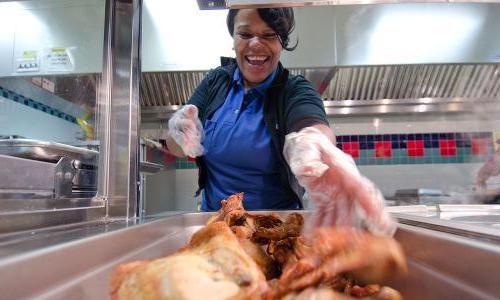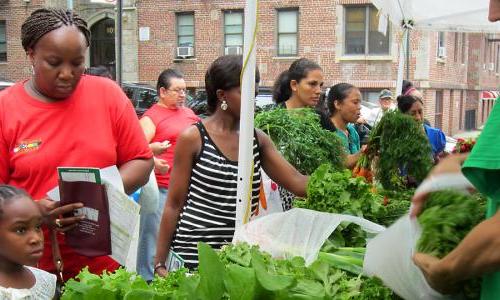中型家庭农场——历史上是美国农村经济的支柱——已经消失了近二十年, 由large代替, 工业化农场. When they disappear, many jobs evaporate with them. 随着以中型农场为代表的就业和商业机会的持续流失,曾经充满活力的农村社区面临着持续的风险.
好消息是,这个问题的解决办法可能就在家门口:超市和医院等大型食品采购商从当地农民那里购买水果和蔬菜, they create a market niche that midsize farms are ideally suited to fill. 旨在帮助中型农场蓬勃发展并将其与这些买家联系起来的政策可以扭转中型家庭农场的衰落,并为农村社区提供急需的经济提振.
我们2016年的报告, 经济增长, uses Iowa as a test case to show how recent research supports this idea. 该报告还建议改变政策,以促进中型农场的复兴.
Midsize farms are good for rural communities
研究表明,中型农场为其社区提供了多种经济效益:
- They employ more people per acre than large, 工业化农场.
- 他们更有可能在当地购买投入物,让更多的钱留在当地经济中.
- Areas having more moderate-size farms have lower poverty and unemployment rates, 更高的平均家庭收入, 社会经济更加稳定, while larger farms are associated with lower incomes, 更多的贫困和经济不平等, less active "main streets" with fewer retail businesses, and less money spent in the community.
Midsize farms have environmental benefits, too. 需要管理的土地更少了, farmers are more in tune with subtleties of soil type, 617888九五至尊娱乐, 害虫种群, and the like—and when family farms are passed from generation to generation, this location-specific knowledge is passed along too.
这种对土地的深入了解,往往允许在与牲畜相结合的系统中生产和轮作各种作物. As a result, midsize farms are often quite biodiverse. 相比之下, large farms tend to restrict production to one or two crops and just a few livestock breeds, 减少生物多样性. 大型农场使用的工业方法也对土壤和水质产生不利影响,并增加全球变暖的排放.

Midsize farms are "just right" for large-scale food buyers
At the same time midsize farms are disappearing, consumer attitudes about food are changing. 越来越多的消费者对健康饮食感兴趣,并想知道他们的食物是如何生产的以及由谁生产的. This has led to the rapid growth of farmers markets, community supported agriculture (CSA) programs, 当地杂货店, and "farm-to-fork" programs at restaurants, 学校, 以及其他机构.
在爱荷华州,最近的研究表明,消费者往往愿意花更多的钱购买当地食品. 当地食品市场的增长潜力巨大:爱荷华人每年在食品上的花费超过80亿美元, and only 10 percent of that food is produced locally.
让爱荷华州的食品资金更多地留在该州的一个方法是让更多的机构(如学校和医院)和“中间市场”(如杂货店和餐馆)从爱荷华州的农场购买食品. 这已经开始发生了:2008年的一项研究表明,爱荷华州8个县的当地食品采购从3个机构花费111美元增长到现在,000 in 1998 to 25 institutions spending $1.2008年为800万.
这些大买家可以帮助中型农场留在农村社区,或者把它们带回爱荷华州和其他地方. Intermediate and institutional buyers require both large volumes and a diversity of foods. 无论是小农场(缺乏产能)还是大农场(缺乏灵活性)都无法满足爱荷华州等地的这种需求. This leaves midsized farms as untapped resources in the local food movement.
Large-scale food buyers + midsize farms = more farms, jobs, $ for Iowa
根据爱荷华州立大学利奥波德中心在2012年和2013年进行的调查数据, 该报告估计,增加从中型农场购买的机构和中间食品会产生以下影响:
- 如果爱荷华州只有25%的中间和机构市场购买当地食品的水平与调查对象相同, this would generate more than $800 million annually for the state's economy. At 50 percent, that figure jumps to $1.67 billion, and at 100 percent, more than $3 billion.
- If half these local food purchases were sourced from midsize farms, 4之间,249和16,可以支持997个这样的农场. 即使是更低的数字,也意味着爱荷华州在2007年至2012年间损失的中型农场的近75%将得到恢复.
- 这样的销售可以支持44,000和178,在爱荷华州总共有1000个517888九五至尊娱乐岗位, 其中包括12,000 to 49,000个全职农场517888九五至尊娱乐和1,400 to 5,500个基于买家的517888九五至尊娱乐岗位.

政策建议
在这一点上,你可能会问, "if the demand is there and midsize farms are well positioned to meet it, 为什么现在还没有发生呢?“答案是,对于希望建立新的中型农场的农民来说,道路尚未扫清, or for existing commodity farms to transition to this kind of farming. There are many challenges to be overcome, including opportunity costs for transitioning farmers, the difficulties of adopting new methods and different equipment, and lack of access to capital or crop insurance.
因为为当地市场服务的中型农场的增长可以为社区带来许多好处, it's in the public interest to help farmers get over these barriers. 要做到这一点, UCS建议未来的联邦食品和农业政策纳入并强调以下内容:
- 财政激励措施 帮助开始和过渡的农民种植机构和中间买家想要的食物.
- 研究和技术援助 to help farmers adopt midsize, diversified farming systems.
- Investments in infrastructure and coordination to get healthy food from farm to market.
- A comprehensive national food and farm policy that incorporates the above recommendations.







